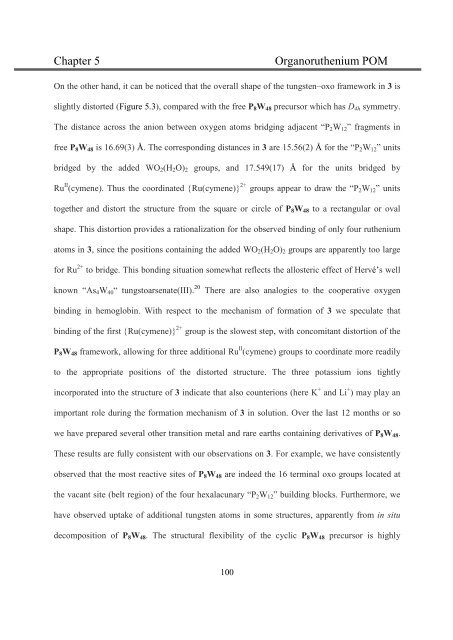Chapter 4 - Jacobs University
Chapter 4 - Jacobs University
Chapter 4 - Jacobs University
Create successful ePaper yourself
Turn your PDF publications into a flip-book with our unique Google optimized e-Paper software.
<strong>Chapter</strong> 5<br />
Organoruthenium POM<br />
On the other hand, it can be noticed that the overall shape of the tungsten–oxo framework in 3 is<br />
slightly distorted (Figure 5.3), compared with the free P 8 W 48 precursor which has D 4h symmetry.<br />
The distance across the anion between oxygen atoms bridging adjacent “P 2 W 12 ” fragments in<br />
free P 8 W 48 is 16.69(3) Å. The corresponding distances in 3 are 15.56(2) Å for the “P 2 W 12 ” units<br />
bridged by the added WO 2 (H 2 O) 2 groups, and 17.549(17) Å for the units bridged by<br />
Ru II (cymene). Thus the coordinated {Ru(cymene)} 2+ groups appear to draw the “P 2 W 12 ” units<br />
together and distort the structure from the square or circle of P 8 W 48 to a rectangular or oval<br />
shape. This distortion provides a rationalization for the observed binding of only four ruthenium<br />
atoms in 3, since the positions containing the added WO 2 (H 2 O) 2 groups are apparently too large<br />
for Ru 2+ to bridge. This bonding situation somewhat reflects the allosteric effect of Hervé’s well<br />
known “As 4 W 40 “ tungstoarsenate(III). 20<br />
There are also analogies to the cooperative oxygen<br />
binding in hemoglobin. With respect to the mechanism of formation of 3 we speculate that<br />
binding of the first {Ru(cymene)} 2+ group is the slowest step, with concomitant distortion of the<br />
P 8 W 48 framework, allowing for three additional Ru II (cymene) groups to coordinate more readily<br />
to the appropriate positions of the distorted structure. The three potassium ions tightly<br />
incorporated into the structure of 3 indicate that also counterions (here K + and Li + ) may play an<br />
important role during the formation mechanism of 3 in solution. Over the last 12 months or so<br />
we have prepared several other transition metal and rare earths containing derivatives of P 8 W 48 .<br />
These results are fully consistent with our observations on 3. For example, we have consistently<br />
observed that the most reactive sites of P 8 W 48 are indeed the 16 terminal oxo groups located at<br />
the vacant site (belt region) of the four hexalacunary “P 2 W 12 ” building blocks. Furthermore, we<br />
have observed uptake of additional tungsten atoms in some structures, apparently from in situ<br />
decomposition of P 8 W 48 . The structural flexibility of the cyclic P 8 W 48 precursor is highly<br />
100

















